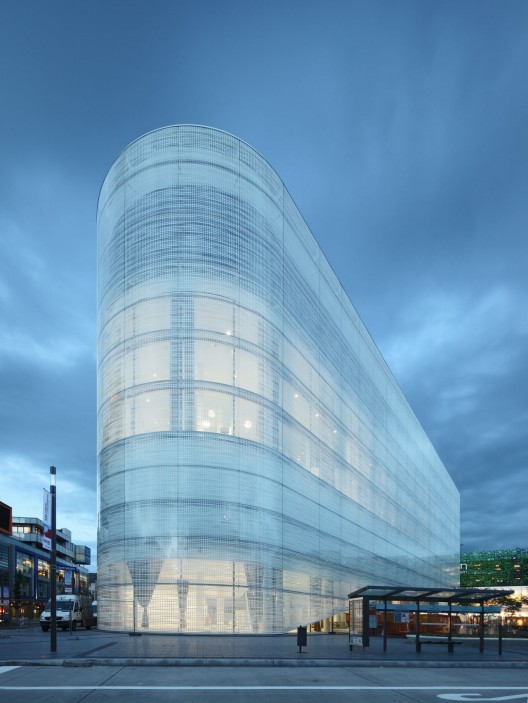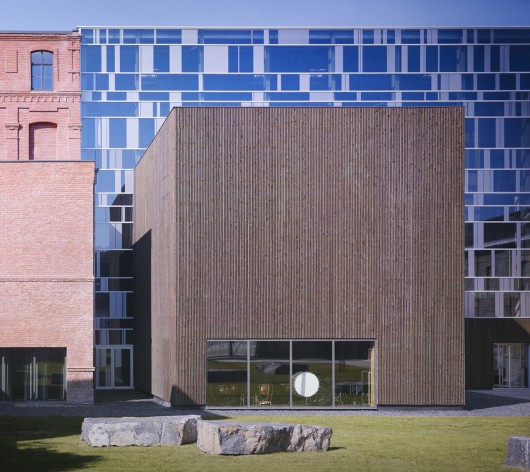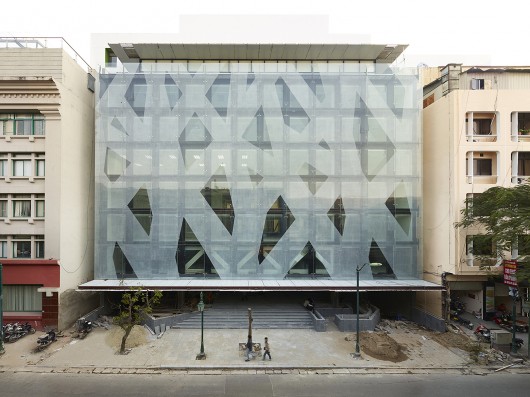These are projects with printed glass:
 |
| Source: Herzog & de Meuron |
Ricola-Europe SA, Production and Storage Building, Mulhouse-Brunstatt, France, 1998 designed by Herzog & de Meuron
Both long walls are light walls providing the work area with constant, pleasantly filtered daylight. Light filtering occurs through printed translucent polycarbonate façade panels, a common industrial building material. Using silkscreen, these panels are printed with a repetitive plant motif based on photograph’s by Karl Blossfeldt. -- architect's web site
 |
| Source: Herzog & de Meuron |
Institute for Hospital Pharmaceuticals, Rossettiareal, Basel, Switzerland, 1998 designed by Herzog & de Meuron
The distinctively spatial shape of the building is accentuated by its bottle green cladding, a printed glass paneling. The shiny glass façades generate a spatial depth that is juxtaposed with matte surfaces of ivy that replace the glass and constitute the façade in certain selected areas. Sections of the façade protrude and retreat in a rhythmic flow that includes the structures and walls of neighboring buildings. -- architect's web site
 |
| Source: Herzog & de Meuron |
IKMZ BTU Cottbus, Information, Communications and Media Centre, Brandenburg University of Technology, Cottbus, Germany, 2001 designed by Herzog & de Meuron
it would be a solitary landmark within the surrounding urban architecture that would communicate the new spirit of the university and relate to the enviroment in many different ways.
The amoeba-like ground plan seems to spread and flow into the surrounding landscape.-- architect's web site
 |
| Source: Jan Bitter archdaily.com |
Utrecht Library, Utrecht, The Netherlands, 2004 designed by Wiel Arets Architects
the facade a play of alternating transparent and opaque panels. They are blurred by a repeated texture, printed on the glass and carved in relief on the black concrete panels. The texture is a pattern of jungle trees, which add some vertical movement to the facade composition. Some of the glazed panels are doubled, and slightly shift off the façade line, making it three-dimensional and contributing to regulate the sunlight. Their opening is automatically controlled in relation with the sun exposure, but they can also be opened manually. -- ArchDaily
 |
| Source: archdaily.com |
Inotera Headquarters & Production Facility, Taipei, Taiwan, 2004 designed by tec Design Studio
An intricate assemblage of printed glass utilizing the latest glass printing technologies, structural glass and glass curtain wall systems, articulates a building that seeks to defi ne its unique identity while assimilating local customs. In contrast to the transparent office structure, an attached fabrication facility provides a fantastic screen for a dada-esque ceramic tile composition that dilutes its scale by use of perspective geometries. -- ArchDaily
 |
| Source: Christian Richters archdaily.com |
Gingko Project, Beekbergen, The Netherlands, 2007 designed by Casanova + Hernandez Architects
The glazed facade has been specially designed with a print of ginkgo tree leaves of different green and yellow tones that react to the constant changing light of the sky creating very special effects, reflections, shadows and silhouettes, depending on the time of the day and the season of the year. -- ArchDaily
 |
| Source: Luc Boegly archdaily.com |
Apartment Blocks, Nanterre, France designed by X-TU
In fact the south facade has a continuous glazed outer layer that forms a glasshouse in winter and provides ventilation in summer. The double skin of the south facade optimises passive solar gain and the overhanging slabs serve the same purpose as awnings, protecting the interior from the sun. This glazed layer – composed of “nako”-type adjustable horizontal slats – unifies the volume of the building. The slatted windows give substance to the facade, like a taut veil drawn across the occupational diversity of these spaces. So everyone can express coherently a clear individuality whilst preserving the general harmony. -- ArchDaily
 |
| Source: designcrack.com |
The IAC Building, New York City, New York, USA, 2007 designed by Frank Gehry
Horizontal, fritted white bands line the windows, an oddly decorative element meant to control the flow of light inside. The windows’ prefabricated panels meet the ground abruptly, their aluminum frames lining up end to end in a neat grid. -- New York Times
 |
| Source: Boeri Studio archdaily.com |
RCS Building, Via Angelo Rizzoli, 8, 20132 Milan, Italy, 2007 designed by Boeri Studi
The entire body of the building is coated evenly on all sides by a double skin, consisting of modular metal panels internally insulated, and a layer of outer coating glass sheets supported at about 20 cm away from the facade. On each floor the ribbon windows “cut ” the modular coating, leaving only a few scattered points of continuity.The plates of the second coating of skin are affected by color variations obtained through layers of silk-screen prints , which give the facades a shimmering vibration depending on the degree and intensity of solar incidence . Similarly, the reflection of light on the metal elements of support, contributes to accentuate this effect. -- ArchDaily
 |
| Source: Naoomi Kurozumi archdaily.com |
T.S.R.Building, Minatu-Ku Tokyo, Japan, 2008 designed by Jun’ichi Ito Architect & Associates
The TSR building is a sustainable building and is good for the environment. There are several basic concepts incorporated in this regard. Reuse: We reduced the CO2 emissions the dismantling by using the underground frames of the old buildings. Drawing of old pillars and dismantling of underground frames reduce the emissions significantly. Control of heat environment: We included argon gas internally by using low-emissivity or “Low-e” glass. Furthermore, ceramic printing was performed on the glass. The ceramic print reduced the solar heat load indoors and enhanced energy conservation. -- ArchDaily
 |
| Source: Christian Gahl archdaily.com |
Benois House, Sverdlovskaya naberezhnaya, 44, Saint Petersburg, Russia, 2008 designed by NPS Tchoban Voss
The design of the new construction is dedicated to the artist A. Benois, especially to his theatre designs that made the Russian art and culture world famous being a part of the Diagelev’s Russian Seasons. The floor-to-ceiling printed glazing is combined with the transparent glass elements in an aluminium-post and rail-construction that straddles the whole façade being a substructure. -- ArchDaily
 |
| Source: ABSCIS Architecten archdaily.com |
Service Station Herverlee, Heverlee, Belgium, 2008 designed by ABSCIS Architecten
The principle building is constructed using a ‘superstructure’ consisting of a canopy and a roof. The roof is carried by columns made from white concrete. These columns are positioned in a crisscross formation. Infill modules created in glass, with a negative imprint of leafy trees, slide underneath the super structure to emphasise the transparency of the structure set against the white surroundings. -- ArchDaily
 |
| Source: predock.com |
Mesa Del Sol Town Center, Albuquerque, New Mexico, USA, 2009 designed by Antoine Predock
The glass facade with multiple missions of iconography, sustainability, and public theater backdrop for video projection at night, is a spatial “catcher’s mitt” for the University Blvd. axis. -- architect's web site
 |
| Source: Miguel de Guzmán archdaily.com |
SESCAM, Toledo, Spain, 2009 designed by FPC+BGT Estudio de Arquitectura
The façade enclosure of the lineal block is solved by a flat glass surface that values the material quality as the building epidermis, with a simple technological solution. It is a continuous silkscreen glass skin sensitive to the sun light tints that isolate the building against s the climatic variations to guarantee its energetic balance. -- ArchDaily
 |
| Source: archdaily.com |
Tattoo House, Victoria, Australia designed by Andrew Maynard Architects
The tattoo was conceived as a continuation of the tree graphic around the simple white box- to soften the impact of this modern addition to a resolutely 19th-century neighbourhood. Furthermore the design was a neighbourly gesture. The household to the west has a manicured garden which is very important to the resident. A stencil of vegetation was created in-house and applied by the AMA team in a covet operation to give the neighbour an additional, though less than manicured, layer of garden. -- ArchDaily
 |
| Source: Logon archdaily.com |
Shanghai Museum of Glass, Shanghai, China, 2011 designed by Logon Architecture
The facade is made from U shaped glass imported from Germany, sand blasted and enameled to reveal transparent glass-related words in various languages. Behind the glass facade is a LED backlight that allows light to glow through each word on its black background; the final effect is breathtaking by night. -- ArchDaily
 |
| Source: Dennis Gilbert archdaily.com |
Walsall Housing Group HQ, Walsall, West Midlands, UK, 2011 designed by Bisset Adams
The building has been welcomed as a new landmark with its memorable high performance glazed façade with abstract tree graphic, making reference to the town’s historic arboretum. -- ArchDaily
 |
| Source: Burckhardt + Partner archdaily.com |
Extension Nestle Research Center, Vers-chez-les-Blanc, Switzerland, 2011 designed by Burckhardt + Partner
A clean monolith of same dimensions, with similar grids to the existing building, is realized by using a black, screen printed glass front. -- ArchDaily
 |
| Source: Persbureau van Eijndhoven archdaily.com |
Glass Farm, Schijndel, The Netherlands, 2012 designed by MVRDV
By coincidence, the maximum envelope that was defined by the town planners had the form of a traditional Schijndel farm. All remaining historical local farms were measured, analyzed and an ideal average was conceived from this data. In collaboration with MVRDV, artist Frank van der Salm photographed all the remaining traditional farms, and from these an image of the typical farm was composed. This image was printed using fritted procedure onto the 1800m2 glass facade, resulting in an effect such as a stained glass window in a cathedral. The print is more or less translucent depending on the need for light and views. -- ArchDaily
 |
| Source: van Dongen-Koschuch archdaily.com |
Kunstcluster, Nieuwegein, The Netherlands, 2012 designed by van Dongen-Koschuch
The glass façade is printed, to give the illusion of (stage) curtains. This applied print also considerably reduces the percentage of light penetration via the south and east façade, preventing overheating on sunny days. The foyers, and therefore most people, are located on the Stadsplein façade to the south. Here, the pigment of the print is sufficiently transparent and translucent to make the image visible from inside to outside, and from outside looking in. -- ArchDaily
 |
| Sourtce: Marty Llagan archdaily.com |
Zuellig Building, Manila, Philippines, 2012 designed by SOM
The signature curtain wall glazing system employed utilizes a ceramic frit pattern for its distinctive exterior aesthetic. The dual pane low-e glazing in conjunction with the fritting ensures minimal solar gain and energy loss whilst simultaneously flooding 90% of the interior office space with natural daylight. The integral frit pattern takes inspiration from local organic motifs while reinforcing the vertical aspect of the tower. -- ArchDaily
 |
| Source: Thomas Eicken archdaily.com |
Kulturbau, Zentralplatz, Koblenz, Germany, 2013 designed by Benthem Crouwel Architects
The volume has a double facade with a Structural-Glazing construction of white silk-screened glass, which envelops the building like a second skin and offers a frosted and refined appearance. The motif of the print provides a filtered view from inside to outside, and allows a vaguely transparent view when looking from the outside in. At the different entrances, the outer facade has a spacious cut and therefore offers a direct view of the lobby and entrance areas. -- ArchDaily
 |
| Source: Julien Lanoo archdaily.com |
Music Academy Of Roubaix, Roubaix, France, 2013 designed by zigzag architecture
Three volumes, projected in the main garden, animate the new façade. Their difference depth sketch a new relation with the environment. -- ArchDaily
 |
| Source: Aleksey Naroditsky archdaily.com |
Seasons Ensemble, Saint Petersburg, Russia, 2013 designed by NPS Tchoban Voss
The design of the fully glazed, printed facades shows floral motifs, reminiscent of the former park on the site, and varies the theme of three seasons. -- ArchDaily
 |
| Source: Régis Golay archdaily.com |
Coalimex, Hanoi, Hoàn Kiếm District, Hanoi, Vietnam, 2013 designed by group8asia
The main façade, which is directly in contact with the street, gives its strong identity to the Coalimex building and deals with its constraints. It is made of double-layered glass. On the second layer, a pattern that interprets the meeting of the trees of the Hanoi streets and the coal (symbol of the client) is printed on the glass. -- ArchDaily
 |
| Source: Jan Bitter archdaily.com |
Allianz Headquarters, Richtistrasse, Wallisellen, Switzerland, 2014 designed by Wiel Arets Architects
This new district’s master plan mandated that all building façades be composed of natural stone, yet it was chosen to frit this building’s full glass façade with an abstracted pattern of Onyx marble–from Mies van der Rohe’s Barcelona Pavilion–which allows the building to blend into its context while simultaneously maintaining its distinguished stance. Each element of the façade contains a closed cavity system, in which an aluminum coated silver curtain hangs, which fluctuates its degree of shading by responding to external environmental factors–a process administered by a computer controlled algorithm. -- ArchDaily
If you had financial problems, then it is time for you to smile. You only need to contact Mr. Benjamin with the amount you wish to borrow and the payment period that suits you and you will have your loan within three working days. I just benefited for the sixth time a loan of 700 thousand dollars for a period of 180 months with the possibility of paying before the expiration date. Mr Benjamin has be helping me with loan.Make contact with him and you will see that he is a very honest man with a good heart.His email is lfdsloans@lemeridianfds.com / lfdsloans@outlook.com and his WhatApp phone number is + 1-989-394-3740
ReplyDeletebrandcaresolutions
ReplyDeletebrandcaresolutions
brandcaresolutions
brandcaresolutions
brandcaresolutions
brandcaresolutions
brandcaresolutions
brandcaresolutions
brandcaresolutions
brandcaresolutions
brandcaresolutions
brandcaresolutions
brandcaresolutions
brandcaresolutions
brandcaresolutions
brandcaresolutions